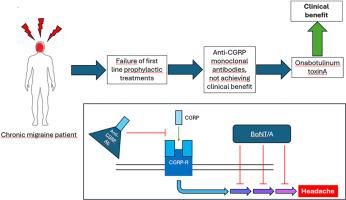Botulinum toxin as an effective rescue treatment after failure of anti-CGRP monoclonal antibodies in chronic migraine patients
IF 2.4
4区 医学
Q2 PHARMACOLOGY & PHARMACY
引用次数: 0
Abstract
anti-CGRP monoclonal antibodies (anti-CGRP mAbs) represent a highly effective prophylactic treatment for chronic migraineurs, but for some subjects they are ineffective. We aimed to determine if OnabotulinumtoxinA (BoNT/A) treatment may be helpful in these cases. We collected data from fourteen chronic migraineurs who attended our Headache Center and who did not benefit from anti-CGRP mAbs treatment. After anti-CGRP mAbs failure, these patients underwent at least one BoNT/A treatment according to the PREEMPT protocol. We then compared the variation in headache days (DOH), pain intensity (NRS), and symptomatic medication intake (ADI) before and after anti-CGRP mAbs therapy and before and after BoNT/A treatment: we confirmed that the interruption of anti-CGRP mAbs treatment had actually been due to a lack of benefit in terms of DOH (19.21 ± 7.58 days and 20.29 ± 8.32 days; p = 0.74), NRS (7.64 ± 0.75 vs 7.57 ± 1.01; p = 0.85) and ADI (42.86 ± 52.74 vs 45.64 ± 52.82; p = 0.79). All patients started BoNT/A therapy after discontinuing anti-CGRP mAbs. After a period without treatment, therapy with BoNT/A caused a significant reduction in DOH (23.86 ± 6.97 vs. 11.36 ± 10.10, p = 0.010), ADI (47.07 ± 51.19 vs. 20.50 ± 21.42, p = 0.010) and NRS (8.07 ± 1.00 vs. 6.64 ± 1.60, p = 0.014), improving clinical conditions in patients non-responders to anti-CGRP mAbs. It is not well established on which basis pharmacological resistance to anti-CGRP mAbs develops in such refractory patients. Still, these data may point towards a mechanism of pain relief that could not be solely related to CGRP pathways activity, thus being a good rescue therapy in resistant headache management, although further data are needed. Our preliminary results suggest that BoNT/A may be a promising salvage therapy option when anti-CGRP mAbs are ineffective, but evidence requires confirmation from basic research and in larger, uncontrolled, prospective studies in chronic migraineurs.

肉毒杆菌毒素作为慢性偏头痛患者抗cgrp单克隆抗体失败后的有效抢救治疗
抗cgrp单克隆抗体(anti-CGRP mab)是一种非常有效的慢性偏头痛预防治疗方法,但对某些受试者无效。我们的目的是确定onabotulintoxina (BoNT/A)治疗是否对这些病例有帮助。我们收集了14例慢性偏头痛患者的数据,这些患者在我们的头痛中心就诊,并且没有从抗cgrp单克隆抗体治疗中获益。在抗cgrp单克隆抗体失败后,这些患者根据PREEMPT方案接受了至少一次BoNT/A治疗。然后我们头痛天(度)的变化相比,疼痛强度(NRS),和有症状的药物摄入量(ADI)之前和之后anti-CGRP马伯疗法和肉毒毒素/治疗:之前和之后我们确认中断anti-CGRP马伯治疗是由于缺乏效益的度(19.21±7.58天,20.29±8.32天;p = 0.74),评分量表(7.64±0.75 vs 7.57±1.01;p = 0.85)和ADI(42.86±52.74 vs 45.64±52.82;p = 0.79)。所有患者在停用抗cgrp单克隆抗体后开始BoNT/A治疗。在一段时间未治疗后,BoNT/ a治疗导致DOH(23.86±6.97比11.36±10.10,p = 0.010)、ADI(47.07±51.19比20.50±21.42,p = 0.010)和NRS(8.07±1.00比6.64±1.60,p = 0.014)显著降低,改善了抗cgrp单抗无反应患者的临床状况。这类难治性患者对抗cgrp单克隆抗体产生药理学耐药的基础尚不清楚。尽管还需要进一步的数据,但这些数据可能指向一种疼痛缓解机制,这种机制可能不仅仅与CGRP通路的活性有关,因此在难治性头痛管理中是一种很好的救援疗法。我们的初步结果表明,当抗cgrp单克隆抗体无效时,BoNT/A可能是一种有希望的挽救性治疗选择,但证据需要基础研究和更大规模的、无对照的、前瞻性的慢性偏头痛研究来证实。
本文章由计算机程序翻译,如有差异,请以英文原文为准。
求助全文
约1分钟内获得全文
求助全文
来源期刊

Toxicon
医学-毒理学
CiteScore
4.80
自引率
10.70%
发文量
358
审稿时长
68 days
期刊介绍:
Toxicon has an open access mirror Toxicon: X, sharing the same aims and scope, editorial team, submission system and rigorous peer review. An introductory offer Toxicon: X - full waiver of the Open Access fee.
Toxicon''s "aims and scope" are to publish:
-articles containing the results of original research on problems related to toxins derived from animals, plants and microorganisms
-papers on novel findings related to the chemical, pharmacological, toxicological, and immunological properties of natural toxins
-molecular biological studies of toxins and other genes from poisonous and venomous organisms that advance understanding of the role or function of toxins
-clinical observations on poisoning and envenoming where a new therapeutic principle has been proposed or a decidedly superior clinical result has been obtained.
-material on the use of toxins as tools in studying biological processes and material on subjects related to venom and antivenom problems.
-articles on the translational application of toxins, for example as drugs and insecticides
-epidemiological studies on envenoming or poisoning, so long as they highlight a previously unrecognised medical problem or provide insight into the prevention or medical treatment of envenoming or poisoning. Retrospective surveys of hospital records, especially those lacking species identification, will not be considered for publication. Properly designed prospective community-based surveys are strongly encouraged.
-articles describing well-known activities of venoms, such as antibacterial, anticancer, and analgesic activities of arachnid venoms, without any attempt to define the mechanism of action or purify the active component, will not be considered for publication in Toxicon.
-review articles on problems related to toxinology.
To encourage the exchange of ideas, sections of the journal may be devoted to Short Communications, Letters to the Editor and activities of the affiliated societies.
 求助内容:
求助内容: 应助结果提醒方式:
应助结果提醒方式:


